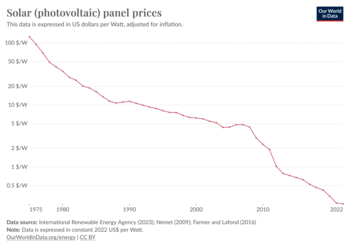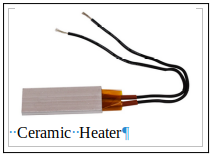PHOTOVOLTAIC SOLAR COOKING
WITHOUT BATTERIES
WITH PTC CERAMIC HEATERS
General summary of the documentation:
- Home
- Presentation of the cooker
- Design of the cooker
- 1 - Building and using a cooker
- 2 - Building a cooker: appendices
- 3 - Theoretical presentations
- 4 - Technical information
- 5 - Photovoltaic panel supports
- 6 - Automation of PTC ceramics
- 7 - Photovoltaic solar water heater
- 8 - Library
- Who are we?
the parts shown in grey are still under construction.
DESIGN OF THE COOKER
The architecture of the cooker is entirely underpinned by the use of ceramic resistors, with multiple consequences.
- A) Lower prices for photovoltaic panels
- B) PTC ceramic resistors
- C) Ceramics and electricity
- D) Ceramics and lower costs
- E) Céramiques et thermique
- F) Céramiques et conduite du capteur
A) The fall in the price of photovoltaic panels
The drastic fall in the price of photovoltaic electricity has made possible what
would have been unthinkable in the last century: using photovoltaic energy
to produce thermal energy.

B) PTC ceramic resistors
Like all resistors, ceramic material produces heat when an electric current is
passed through it. But as it heats up, its electrical resistance decreases, and
at 200°C it is divided by three compared with the ambient temperature, so its
heating power is multiplied by three. Then, above 200°C, resistance rises sharply
until it becomes very high, so the electric current can no longer flow, and heat
production stagnates.
 Although little known to the general public, ceramic resistors are very
common in everyday life. For example: small ceramic heaters, available in all
household electrical goods stores and sold as auxiliary heaters, are a good
example. Small and light, they must be fitted with a fan that continuously
expels the calories produced by the ceramic, otherwise the heat production
would stagnate.
Although little known to the general public, ceramic resistors are very
common in everyday life. For example: small ceramic heaters, available in all
household electrical goods stores and sold as auxiliary heaters, are a good
example. Small and light, they must be fitted with a fan that continuously
expels the calories produced by the ceramic, otherwise the heat production
would stagnate.
The characteristics of ceramic heating elements are very interesting for our cooker:
- there is no risk of the heating elements burning out.
- a temperature of 200° is more than enough for all boiling, braising, steaming, etc.,
with the exception of cooking in oil and grilling.
- 200° is lower than the ignition temperature of cotton.
C) Ceramics and electricity
The usual electrical resistors (electric hobs, heaters, toasters, etc.) are designed
to operate at a well-defined electrical voltage (= "Voltage"), supplied by the mains,
for example 230 Volt, plus or minus small variations that are technically permissible
but transparent to the user. The laws of electricity teach us that, in the event
of a significant drop in voltage, heat production collapses, and that in the event
of too great an increase in voltage ("overvoltage") the resistor is destroyed,
it burns out.
Given that all conventional electrical equipment only works on a correctly
regulated voltage, all photovoltaic installations need to regulate the electrical
current using a battery flanked by a charge regulator at the input and an
inverter at the output.
Ceramic resistors can withstand significant variations in current without
the risk of burn-out.
The ceramic resistors used for the cooker operate at a voltage of 25 to 40 volts,
corresponding directly to the current produced by a photovoltaic panel,
and which remains below the safety threshold for direct current, set by
regulations at 48 volts. So users are safe.
D) Ceramics and lower overall cooker costs
All other things being equal (industrial mass production, etc.), a ceramic cooker
is not intrinsically much more expensive than an ordinary electric cooker.
The main advantage in terms of cost comes from the absence of a battery
and its two power regulation acolytes. In a "conventional" solar electric
cooking system, it is the battery that is the most expensive, the most fragile,
the most polluting and the most dangerous component (see part 8, "Library").
Removing the battery could be the decisive factor in converting to solar
electric cooking.
But the ceramic cooker works very well on battery power. And when the
battery dies, the cooker will still be able to run on solar power.
E) Ceramics and heat
The maximum temperature of ceramics, around 200 to 220°C, is lower than
the ignition temperature of cotton. It is therefore possible to insulate the
whole device, heating block and container, for example with cotton towels,
or similar. This significantly improves the efficiency of the cooker, and
relatively lowers the overall cost of the installation per unit of energy
produced: "efficiencies are multiplicative (and so are losses...)".
You can also choose not to insulate, just add solar panels.
Insulation can also be used in the event of temporary cloud cover, in which
ase the cooker continues to operate as a Norwegian kettle. And depending
on the food to be cooked, it is possible to work alternately with two cookers
on a single sensor: one cooker rises in temperature while the other continues
cooking under insulation, and vice versa.
F) Ceramics and operating the cooker
The output of a photovoltaic collector depends on the amount of sunlight
it receives, but also (and this is not intuitive!) on the load applied to it.
Fortunately, ceramic resistors have a wide operating range. In the event
of significant variations in sunshine, the number of ceramic elements in
operation needs to be modified, and to get closer to the optimum the driver
has a small voltmeter at his disposal.
If the weather is fine, the driver can choose the number of resistors in
operation and go about his business.
If the aim is to produce hot water in a water heater as described in Part 7,
intended to operate throughout the day, the installation can be automated
using a micro-controller of the Arduino or other type.


